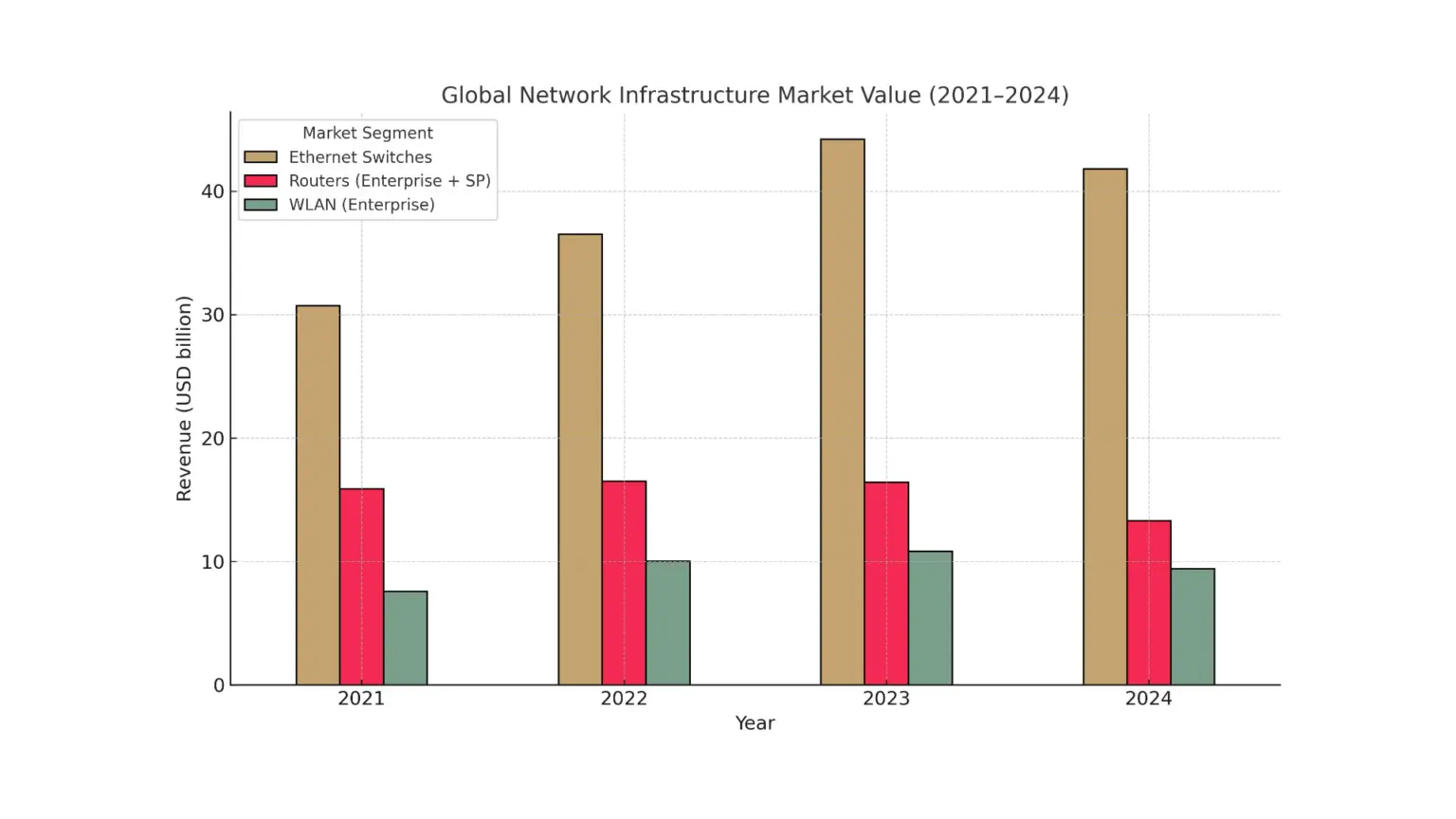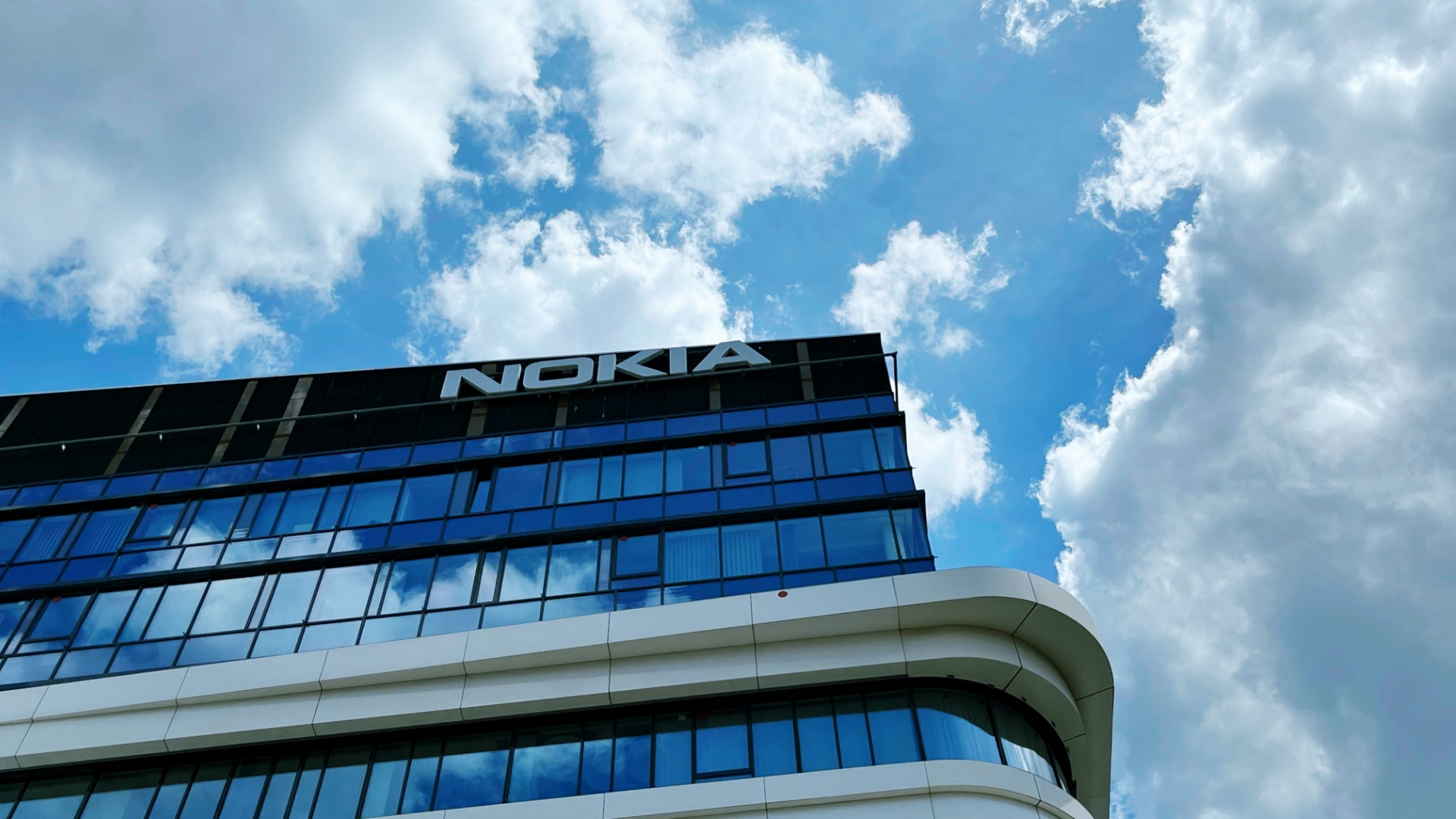The network infrastructure market is the foundation of the digital economy – encompassing hardware, software and services that provide connectivity and data exchange on a global scale. The dynamic development of mobile technology, cloud computing and the Internet of Things (IoT) is driving investment in modern networks. As a result, network infrastructure is undergoing intense modernisation: telecom operators are deploying 5G, companies are migrating to the cloud and the hybrid working model, and organisations are betting on network automation. This article analyses the current value of the global network infrastructure market, its growth forecasts, regional differentiation, key technology trends (5G, edge computing, SD-WAN, AI) and key market players. It also provides an expert assessment of the outlook for the next 5-10 years and the key challenges – from costs to security to problems with outdated systems.
Market value and growth forecasts
The global network infrastructure market is worth hundreds of billions of dollars and is showing steady growth. Its value reached around USD 248.8 billion in 2024 and is forecast to grow to USD 463.9 billion in 2033. This means that the market will grow at a compound annual growth rate (CAGR) of around 7.2 per cent on average between 2025 and 2033. Such growth reflects the increasing demand for advanced networking technologies around the world – from data centre modernisation, cloud and 5G integration to the development of smart cities. Demand is driven by both the private sector (digital transformation of businesses) and public investment in broadband and mobile infrastructure.
In 2024, the market was valued at just under USD 250 billion, to almost double its value to around USD 464 billion by 2033. The growth trend is relatively uniform and stable – reflecting the maturity of the market and the continued organic growth in demand for network capacity, security and new functionality. Importantly, the structure of the market includes network hardware (around 48% market share) and network software and services (together the remaining 52%), which means that, in addition to investment in physical equipment, the role of software solutions that define network operations is growing.
Regional market structure
Network infrastructure is growing in all regions of the world, but the dynamics and scale of investment vary by area. Asia and the Asia-Pacific region currently represent the largest segment, accounting for around 34% of the global market and showing the fastest growth rate. The main driver here is the expansion of next-generation mobile networks and urbanisation: it is estimated that more than half (51%) of all 5G base stations worldwide are located in Asia-Pacific. Countries such as China, Japan, South Korea and India are leading the way with investments in 5G and smart city projects. For example, some 68% of enterprises in the APAC region are betting on migrating to the cloud, and 59% are deploying advanced industrial networks for smart manufacturing and urban infrastructure.
North America accounts for approximately 31% of the value of the global market and remains at the forefront of deploying the latest network solutions. The US accounts for the lion’s share of this market, with approximately 84% of North American infrastructure investment occurring in the US. The region has the highest density of data centres, widespread fibre availability and a rapid pace of 5G deployment. Already 48% of organisations in North America are using 5G connectivity in their operations. In addition, companies are placing a strong emphasis on security, with nearly 69% of US companies prioritising the integration of cyber security into their network infrastructure. Government programmes supporting network expansion and the widespread digitisation of business are also contributing to the growth.
Europe accounts for approximately 27% of the global network infrastructure market. With key markets in Germany, the UK and France, the region is focusing on modernising corporate and telecom networks based on software-defined networking architectures. Already, some 61% of European enterprises are deploying SDN (Software-Defined Networking) solutions and 58% are investing in multi-cloud strategies – integrating multiple clouds for greater flexibility. European operators and companies are also intensively developing data centre infrastructure and fibre networks, preparing the ground for 5G rollout and future 6G deployments around the end of the decade. Despite a slightly smaller share of the global market, Europe maintains high standards of security and interoperability and is paying increasing attention to the energy efficiency of infrastructure – some 31% of new network investments in Europe and Asia are already directed towards green, energy-efficient technologies.
Other regions are also seeing growth: The Middle East and Africa together account for around 8% of the market, catching up through digital infrastructure projects often funded by government funding and public-private partnerships. Latin America, meanwhile, is investing in the expansion of 4G/5G and fibre networks, although the scale of spending there is smaller compared to the three main regions.
Leading technological trends
Several key technology trends are clearly emerging in the network infrastructure that are shaping the development of the market:
- 5G networks: 5G technology is being deployed globally in mobile operators’ networks, offering many times higher speeds and minimal latency. Investments related to 5G already account for approx. 21% of the total capital expenditure of telcos, and spending on 5G equipment accounts for 24% of telecoms network infrastructure budgets. Fifth-generation networks not only serve the growing mobile traffic of consumers, but also enable the development of new applications – from industrial IoT to autonomous vehicles. Of increasing importance are private 5G networks deployed by industrial and logistics companies that need reliable, unbundled connectivity with ultra-low latency for their own production needs. 5G will continue to be a catalyst for investment in the coming years, with more than 50% of global mobile connections expected to be 5G-enabled by 2029.
- Edge computing: edge computing architectures, or computing at the edge of the network (closer to the data source and the user), are gaining popularity in response to the demands of real-time applications. Some 47% of organisations plan to deploy edge solutions to support critical systems that require minimal latency. Moving computing power closer to users improves the responsiveness of services such as video streaming, online gaming, telemedicine or autonomous vehicle systems. The proliferation of IoT also forces the local processing of huge streams of sensor data. The edge trend goes hand in hand with 5G – an estimated 39% of new network infrastructure projects combine 5G deployments with edge components to provide ultra-low latency and local data analytics for industry, smart cities or energy grids.
- SD-WAN and Software-Defined Wide Area Networks: SD-WAN (Software-Defined Wide Area Network) are solutions that manage wide-area enterprise networks through the software layer, ensuring traffic is optimised between branch offices and the cloud. Demand for SD-WAN is growing exponentially in the age of remote and hybrid working – businesses need flexible and secure access to corporate applications in the cloud regardless of location. More than 68% of companies are shifting to a more flexible working model, stimulating SD-WAN deployments to ensure consistent connectivity and security policies across all departments. SD-WAN solutions, often offered by vendors as a managed service, also reduce data costs through the intelligent use of Internet connections and MPLS networks. A broader context is network virtualisation – SDN and NFV (Network Function Virtualisation) – where network functions, such as routing or firewall, are implemented programmatically. In Europe, the aforementioned ƒ~61% of companies are already using SDN architecture. Global vendors are intensively developing SD-WAN/SDN offerings – an example is Cisco, which in 2024 introduced a new generation of SD-WAN solutions adapted to the hybrid operating model, providing, among other things, 34% faster access to cloud applications while maintaining centralised security control.
- Artificial intelligence (AI) in networks: AI is playing an increasingly important role in both the management of network infrastructure and in new security functions. Network operators and administrators are deploying machine learning algorithms to automate network configuration, monitoring and optimisation. More than 39% of enterprises are using AI-based analytics tools to optimise network performance and detect problems faster. At the same time, equipment manufacturers are integrating AI elements into their products – around 37% of new network devices have AI-based features for threat detection and automated response to security incidents. An example is the next-generation data centre switches from Huawei, equipped with AI mechanisms to increase performance by ~40% and improve traffic management. In the coming years, AI is expected to enable the implementation of so-called self-optimising networks (self-driving networks), which automatically adjust parameters to changing conditions and can predict failures through data analysis (predictive maintenance).
Major market players
The network infrastructure market is dominated by a handful of large global vendors who compete in both the telecoms equipment and corporate network solutions segments. These include Cisco, Huawei, Nokia and Ericsson, among others:
- Cisco Systems (USA): The world’s largest provider of enterprise networking solutions. Cisco leads in the area of network equipment (switches, routers, Wi-Fi access points) and develops advanced software for network management and security. The company is adapting its offering to new trends – investing in SDN/SD-WAN solutions (the aforementioned latest products for software-defined WAN are an example) as well as cloud and data centre solutions. Many corporations base their infrastructure on Cisco hardware as standard, which gives the company a strong market position.
- Huawei (China): A global telecommunications and networking giant that is one of the leaders in the deployment of 5G technology. Huawei offers a full infrastructure portfolio – from access equipment (5G base stations, fibre equipment) to backbone routers and cloud solutions. Together with Cisco, it is among the largest players – together the two companies control nearly 29% of the network infrastructure market share. Huawei has enjoyed tremendous success in the Asian, African and Latin American markets, although in recent years it has struggled with restrictions in some Western markets for geopolitical reasons. Despite this, the company continues to invest in research (including the development of AI-enabled switches for data centres) and maintains a strong position in global vendor rankings.
- Nokia (Finland): One of the two European leaders in telecommunications infrastructure. Nokia (alongside Ericsson) is a leading supplier of equipment for mobile networks – especially for 4G/5G infrastructure (RAN, core network) – as well as optical and IP transport solutions. The company is using its telecoms know-how to enter new areas, such as private 5G networks for industry. In 2023. Nokia announced a number of deployments of private 5G wireless networks for industrial sectors and smart city projects, responding to business customers’ demand for dedicated, high-performance communication networks. Globally, Nokia is competing for 5G contracts with Huawei and Ericsson, with a strong presence in markets where alternatives to Chinese vendors are required.
- Ericsson (Sweden): The second European network infrastructure giant next to Nokia, with more than a century of history in telecommunications. Ericsson specialises in equipment for mobile and radio networks – it is one of the main suppliers of 5G base stations to operators worldwide. The company is also investing in the development of core network solutions, managed services and IoT. With a strong position in North America and Europe, Ericsson is benefiting from operator demand for 5G equipment amid restrictions imposed on Huawei in these regions. In addition, Ericsson is engaged in standardisation work on future technologies (6G) and is working with partners (e.g. cloud providers) to virtualise network functions. As a company focused on the operator segment, Ericsson – like Nokia – complements the offerings of Cisco and Huawei, particularly dominating global mobile access network deployments.
In addition to those mentioned, there are other major players in the network infrastructure market specialising in selected areas – including ZTE, Juniper Networks, Arista Networks, Dell EMC, HPE (Aruba), Extreme Networks or CommScope. The aforementioned companies compete in segments such as data centre switches, campus LAN/WLAN equipment, cabling or cloud solutions, completing the global network infrastructure ecosystem.
Development prospects for the coming years
According to experts, the growth prospects for the network infrastructure market over the next 5-10 years remain very promising. A projected average annual growth rate of 7% means that the sector will grow faster than many traditional industries, although slightly slower than the most dynamic segments of the IT market. The key technology trends described above will continue to drive investment: the global roll-out of 5G (and, looking ahead to the end of the decade, the first 6G deployments) will ensure continued demand for equipment and operator network upgrades. Edge computing will become an integral part of the network architecture – more and more data will be processed locally, creating a demand for distributed network nodes close to the user. Cloud and multicloud solutions will force the construction of networks capable of handling dynamic, distributed workloads, fostering the development of intelligent, software-defined networks. Automation using AI is likely to transform the way networks are managed – we are already seeing a trend towards autonomous networks, able to optimise traffic and respond to incidents autonomously. In the long term, this could result in significant operational savings and improved security.
Regionally, the current balance of power is expected to continue, with Asia-Pacific remaining the largest and fastest-growing market due to investment in China and developing countries, North America maintaining high levels of innovation and corporate spending (especially in the US), and Europe consistently upgrading infrastructure with a focus on security and efficiency. However, the disparity between regions may narrow as network technologies become ubiquitous and deployment costs fall.
Experts also highlight new areas of growth that may become increasingly important: private 5G networks for enterprises (e.g. in factories, ports or university campuses), networks for IoT supporting billions of devices (including narrowband LPWAN networks for sensors) or the development of the satellite internet (e.g. constellations in low orbit providing global connectivity). The digital transformation of sectors such as energy (smart grid), automotive (connected vehicles) or medicine (telemedicine, wearable devices) will generate demand for a reliable communication infrastructure. A further increase in research and development (R&D) spending in the network area can be expected – both by market giants and new players (startups), which will result in further innovations and even more efficient network technologies in the future.
Market challenges
Despite the positive outlook, the global network infrastructure market faces several significant challenges. The biggest barrier is high cost – network upgrades require huge capital expenditure. More than 44% of enterprises cite budget constraints as a factor inhibiting infrastructure upgrades. Next-generation hardware (e.g. 5G devices, backbone routers, edge nodes) and associated software and integration are costly investments that not all organisations can afford immediately. At the same time, obsolete (legacy) systems are still common – it is estimated that around 27% of the network infrastructure in use globally is made up of older, previous-generation equipment. Migrating from these legacy systems is difficult: nearly 38% of companies struggle to replace old hardware with newer hardware. Maintaining such solutions raises not only opportunity costs (lower performance, lack of new features), but also security risks – almost 33% of security breaches are related to vulnerabilities in outdated infrastructure.
Cyber security is itself another challenge. The increasing complexity of networks (especially those distributed across multiple clouds and locations) means that 59% of organisations find it difficult to manage security in multicloud and hybrid environments. Attacks on network infrastructure are increasing in sophistication and the attack surface is widening with the connection of more IoT devices and the proliferation of 5G networks. Ensuring consistent security policies, network segmentation and data protection in such a heterogeneous environment is a heavy burden for IT departments. Many companies also face staff shortages, with some 29% of enterprises citing a shortage of qualified advanced network professionals as a limiting factor to progress.
Another challenge is interoperability and integration of new technologies with existing infrastructure. Companies often use multi-vendor solutions, which raises compatibility issues. More than 34% of organisations experience integration issues when deploying disparate platforms and services. Standardisation of protocols and openness of ecosystems are therefore becoming crucial to avoid technology silos. Additionally, regulators are imposing requirements on the industry (e.g. on cyber security, data privacy or spectrum allocation), which can slow down deployments, especially in the telecoms sector.












